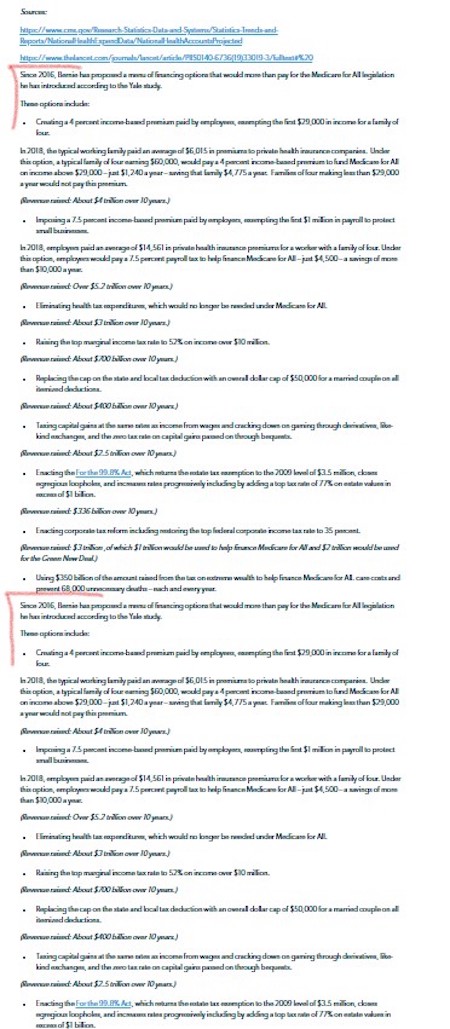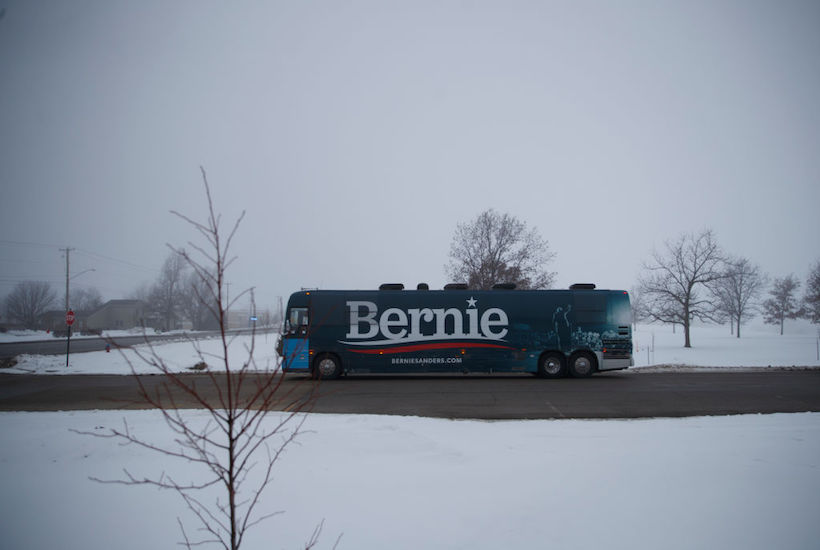In the magical socialist world of Bernie Sanders, everything is free – which means that someone else is paying for it. Usually, it’s the billionaires or the rich or the corporations, as if all these entities possess bottomless pockets and don’t respond to incentives and disincentives by changing their actions – or locations. Bernie’s plans for government depend on everyone out there just sitting and taking it.
Now that the Democratic (or Democratic Socialist) primaries are heating up, with the Bernie emerging as the unlikely front-runner, the man himself has been forced to explain in a bit more detail where the money for all his promises is coming from. You can find the information in the section of the candidate website titled “How Does Bernie Pay For His Major Plans?”
It’s perhaps a cheap shot (cheap but not free) to say that Bernie doesn’t – everyone else does, as has been the story his entire life as an unproductive member of the society.
Two of Bernie’s plans – “Housing For All” (“Bernie’s proposal to guarantee housing as a human right and to eliminate homelessness will cost $2.5 trillion over the next decade.”) and “Universal Childcare/Pre-K” (“Bernie’s proposal to guarantee universal childcare and pre-school to every family in America who needs it will cost $1.5 trillion.”) – are to be paid by the “Tax on Extreme Wealth”, expected to raise $4.35 trillion over the next decade:
This tax on extreme wealth would have a progressive rate structure that would only apply to the wealthiest 180,000 households in America who are in the top 0.1 per cent.
It would start with a 1 percent tax on net worth above $32 million for a married couple. That means a married couple with $32.5 million would pay a wealth tax of just $5,000.
The tax rate would increase to 2 percent on net worth from $50 to $250 million, 3 percent from $250 to $500 million, 4 percent from $500 million to $1 billion, 5 percent from $1 to $2.5 billion, 6 percent from $2.5 to $5 billion, 7 percent from $5 to $10 billion, and 8 percent on wealth over $10 billion. These brackets are halved for singles.
Under this plan, the wealth of billionaires would be cut in half over 15 years which would substantially break up the concentration of wealth and power of this small privileged class.
We’re not talking here about the tax on income or capital gains – we’re talking about essentially expropriating people by forcing them to liquidate their assets and give the proceeds to the state. Forget about the disincentive for the 0.1 per cent to stay in the United States as they are being fiscally mugged; even if all of them remain residents for tax purposes and pay up, how do you finance all that housing and preschool in 30 years’ time after you have eliminated all the billionaires? Clearly, you then need to start moving down the wealth pyramid and taking money from others, starting with millionaires like Bernie himself. I know we’re talking about long term horizons but this is not a sustainable system.
Then there is Bernie’s “Green New Deal”, whereby the US becomes run on 100 per cent renewable in energy and transport by 2030 and completely decarbonised by 2050:
The $16.3 trillion climate change proposal that Bernie has introduced will fundamentally transform our energy system away from fossil fuel and towards energy efficiency and renewable energy. It will also create 20 million good-paying union jobs in the process.
It is fully paid for by:
Raising $3.085 trillion by making the fossil fuel industry pay for their pollution, through litigation, fees, and taxes, and eliminating federal fossil fuel subsidies.
Generating $6.4 trillion in revenue from the wholesale of energy produced by the regional Power Marketing Administrations. This revenue will be collected from 2023-2035, and after 2035 electricity will be virtually free, aside from operations and maintenance costs.
Reducing defense spending by $1.215 trillion by scaling back military operations on protecting the global oil supply.
Collecting $2.3 trillion in new income tax revenue from the 20 million new jobs created by the plan.
Saving $1.31 trillion by reducing the need for federal and state safety net spending due to the creation of millions of good-paying, unionized jobs.
Raising $2 trillion in revenue by making large corporations pay their fair share of taxes.
Essentially, Bernie is abolishing the fossil fuel industries and nationalising energy production. Coal and gas will be taxed and litigated out of existence, though Bernie does not mention what civil or criminal offences these industries are guilty of (no doubt something will be done in that regard; as Beria once said, “Show me the man and I’ll show you the crime”). By the way, the total market capitalisation – i.e. the worth – of the entire fossil fuel industry worldwide is $4.65 trillion; Bernie somehow thinks he will wring two-thirds of it for his budget. Good luck, champ. Again, though, we are talking about the government using various means in its disposal to expropriate a whole significant sector of the economy.
Then there is the twenty million new jobs created; a figure, to use a technical term, pulled out of Bernie’s arse:
Ending unemployment by creating 20 million jobs needed to solve the climate crisis. These jobs will be good paying, union jobs with strong benefits and safety standards in steel and auto manufacturing, construction, energy efficiency retrofitting, coding and server farms, and renewable power plants. We will also create millions of jobs in sustainable agriculture, engineering, a reimagined and expanded Civilian Conservation Corp, and preserving our public lands.
If anything, switching the US economy from the cheap and reliable carbon-generated electricity to the still expensive and unreliable wind and solar (the storage technology necessary for the base power is simply not there yet technologically) will plunge the country into a major economic crisis, causing massive job losses throughout the private sector. But even if the economic laws somehow ceased to operate, there simply are no 20 million jobs magically appearing as a result of a switch from one source of energy to another, particularly since even Bernie acknowledges it will be a long time before electricity will be “virtually free”, thus reducing costs of doing business. And if the bulk of these jobs are instead public jobs, then counting the consequent income tax revenue is a complete sleight of hand. In any case, unemployment is now so low, I’m not sure where Bernie intends to find 20 million people – presumably he will import them from across the border.
Another of Bernie’s multi-trillion promises is his “Medicare For All”, or the free medical care (including drugs) for every American (and illegal in Bernie’s books):
What our current system costs over the next decade:
Over the next ten years, national health expenditures are projected to total approximately $52 trillion if we keep our current dysfunctional system.
How much we will save:
According to the Yale study and others, Medicare for All will save approximately $5 trillion over that same time period.
$52 trillion – $5 trillion = $47 trillion total
How we pay for it:
Current federal, state and local government spending over the next ten years is projected to total about $30 trillion.
The revenue options Bernie has proposed total $17.5 Trillion
$30 trillion + $17.5 trillion = $47.5 Trillion total
So Bernie thinks that you can go from the current “dysfunctional system” to “everything for free” with just an extra $1.75 trillion a year, while completely eliminating the private health insurance. The mixed American health care system might or might not be an overpriced mess, but what Bernie is suggesting is that it will cost less ($5 trillion) to do more for more people if only the sector is wholly managed by the government. Which is something only a socialist can believe.
To get that extra $17.5 trillion for the federal government to spend to guarantee “free health care for everyone”, Bernie is proposing new taxes on pretty much everyone except low income earners. In fact, he loves all his new (or resurrected) taxes so much, the whole section on his website has been pasted twice:

The majority of the $17.5 trillion comes from two broad-based tax measures:
Creating a 4 percent income-based premium paid by employees, exempting the first $29,000 in income for a family of four.
In 2018, the typical working family paid an average of $6,015 in premiums to private health insurance companies. Under this option, a typical family of four earning $60,000, would pay a 4 percent income-based premium to fund Medicare for All on income above $29,000 – just $1,240 a year – saving that family $4,775 a year. Families of four making less than $29,000 a year would not pay this premium.
(Revenue raised: About $4 trillion over 10 years.)
Imposing a 7.5 percent income-based premium paid by employers, exempting the first $1 million in payroll to protect small businesses.
In 2018, employers paid an average of $14,561 in private health insurance premiums for a worker with a family of four. Under this option, employers would pay a 7.5 percent payroll tax to help finance Medicare for All – just $4,500 – a savings of more than $10,000 a year.
(Revenue raised: Over $5.2 trillion over 10 years.)
Granted that the savings for a family of four by the family and its employer are probably above average (savings for an individual would likely be proportionally not as great), but what Bernie is saying is that instead of the family and the employer paying almost $21,000 a year for the private health insurance, they would instead pay just under $6,000 in taxes – yet that would generate over the half of the money needed to expand the health coverage in America (both in terms of numbers and the range of service). Once again, by some magic trick, the government will do more with less, i.e. contrary to the general experience of public sector cost structures and performance.
You start to add up all of Bernie’s promises and they soon get north of $40 trillion over the next ten years. Seeing that the current federal budget is $4.6 trillion and increasing every year, Bernie’s plans will increase the size of the federal government by 80-90 per cent. Probably more, seeing that Bernie has not released and costed all his policies yet, including the federal job guarantee, which the Manhattan Institute estimates could cost another $30 trillion. This would likely make the United States the highest spending OECD country (as the percentage of the GDP). Somewhere at this point mind starts to boggle.
Bernie’s campaign bus is painted with the slogan “Not me – us”, but with all the “free” shit for everyone and tens of trillions of dollars at play, a more accurate and truthful version would say “Not me – you”.
Arthur Chrenkoff blogs at The Daily Chrenk, where this piece also appears.
Got something to add? Join the discussion and comment below.
Got something to add? Join the discussion and comment below.
Get 10 issues for just $10
Subscribe to The Spectator Australia today for the next 10 magazine issues, plus full online access, for just $10.


























Comments
Don't miss out
Join the conversation with other Spectator Australia readers. Subscribe to leave a comment.
SUBSCRIBEAlready a subscriber? Log in